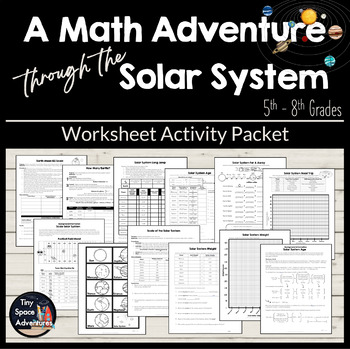A Math Adventure Through the Solar System
- PDF
What educators are saying
Description
8 FUN math activities included to help your students practice their math skills and learn a little bit about their place in their solar system!
Solar System Long Jump
Overview: Students figure out their average long jump on Earth, and then based on the gravity of each planet, calculate the distance of that jump on each planet.
Solar System Weight
Overview: Based on gravity of each planet, students calculate their weight and the measurements of central tendency. Students will then graph their results.
Solar System Age
Overview: Based on the time it takes each planet to orbit the Sun, students calculate their age for each planet and then find measures of central tendency.
Solar System Scale
Overview: Based on the distance from the Sun, estimate how far each planet would be using counters, and then calculate the real scale distance from the Sun using division. Planet cards are provided for optional visuals of the planets’ locations on their scale.
Earth-Moon Scale
Overview: Based on the distance from the Earth, estimate how far the Moon is from the Earth. Then estimate the distance of the International Space Station relative to the Earth and Moon.
Solar System Far and Away
Overview: Find out how far each planet is from the Sun by doing addition problems. But be careful, each problem is dependent on the previous one for the answer.
Solar System Road Trip
Overview: Discover how long it takes to travel from Earth to each planet in our solar system and graph the results.
How Many Earths
Overview: How many Earths can fit into the outer planets? Use planet statistics to calculate the radius and volume of each planet to find the answer.
Relevant background information provided for each worksheet.
Activities meet standards grades 5-8 for Common Core Math, Common Core Literacy in Science and Technical Subjects and the Next Generation Science Standards
This is a PDF non-editable resource.
Download a FREE preview!
Note: this is only a sampling of the activities provided in the lesson.





